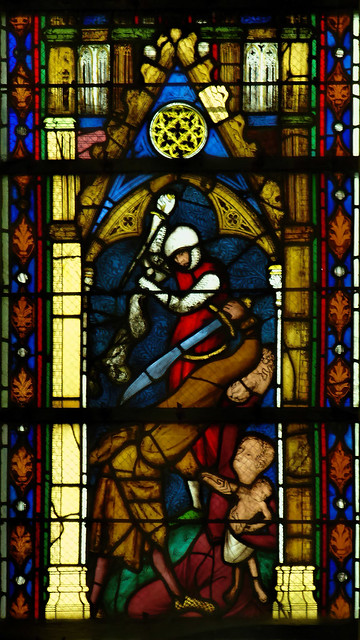Massacre of the Innocents - St Ouen, Rouen
These two stained-glass panels from the choir clerestory of St Ouen form a paired narrative of the Massacre of the Innocents, rendered in the incisive and highly expressive manner characteristic of the early 14th-century Norman workshops. Though each panel stands within its own Gothic architectural frame, complete with gabled canopies, foliate bosses, and alternating bands of strong primary colour, the scenes are conceived as a continuous episode of violent disruption, unfolding across two moments of the same biblical tragedy.

In the first panel, a mailed soldier leans forward in a taut, almost angular pose, raising his sword to strike down a child clutched desperately by its mother. The figures are set against a dense blue diapered ground that intensifies the sense of constriction and panic. The mother twists her body in an attempt to shield her infant, her posture echoing the steep, diagonally stressed lines of the soldier’s attack. The composition is built upon intersecting diagonals, sword, limbs, and drapery all contributing to a sense of sudden movement, while the bright vermilion of the soldier’s surcoat heightens the immediacy of the assault.

The second panel continues the theme with even greater brutality. Here another soldier, bare-headed but equally forceful, seizes an infant by the leg while preparing to cut it down. Beneath him, a woman kneels in powerless supplication as she holds out her child, turning her head away as if unable to witness the impending blow. The background shifts to a rich crimson patterning, contrasting with the first panel’s blue and amplifying the emotional register, red for bloodshed, blue for lamentation. Despite slight differences in execution, the figures share the same stylised modelling, slender proportions, and sharply folded drapery typical of the glazing produced at St Ouen during this period.
Taken together, the two panels present a unified narrative of calculated royal violence, Herod’s command made visible through the repeated gestures of soldiers and the anguished resistance of mothers. Their architectural surrounds, consistent in form and palette, frame the scenes as part of a larger moral cycle, while the figures themselves convey both the compositional sophistication and emotional intensity that mark the finest Norman glass of the second quarter of the 14th century.
